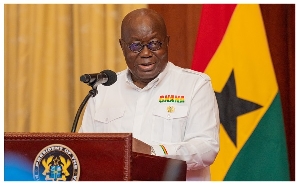General News of Wednesday, 14 April 1999
Source: null
Asantehene-elect to be enstooled on April 26
Kumasi (Ashanti), 14th April ?99 ?
Otumfuo Osei Tutu the second, the Asantehene-elect will be enstooled as the 16th occupant of the Golden Stool and the 19th Asantehene on Monday, April 26.
A statement issued in Kumasi and signed by Mr Isaac Dadzie-Mensah, Registrar of the Ashanti Region House of Chiefs, said the new Asantehene will swear the oath of office, and thereafter all the paramount chiefs in Asanteman would also swear the oath of allegiance to him.
A 24-member enstoolment planning committee under the chairmanship of Nana Otuo Serebour the second, Juabenhene, has been appointed to ensure the smooth and successful enstoolment, the statement added.
Rituals for the enstoolment are performed in the early afternoon at Pampaso, a historical ward near the Kumasi Prisons. This ceremony is called "Nkowasotena" (sitting on a chair) and is quickly followed by firing of muskets at the Manhyia Palace.
On the day of the enstoolment, the Asantehene-elect, pays a customary visit to the Queen of Pampaso. He sends gifts to the Queen. The gifts include a ram, a flask of rum, a full piece of calico, a bag of salt, a Kente cloth and a silk cummerbund. The linguist, who occupies the Kankam and Nantwi stool, takes the gifts to Pampaso. All the items, except the cummerbund, are taken to the Wadie-Adwumakesehene, custodian of the "Busumuru", the most sacred state sword.
As soon as the linguist returns from Pampaso, all items of the Asantehene's regalia except the Golden Stool and the black stool are taken in procession to Pampaso. There they are arranged and guarded by the Gyaasehene, Ankobeahene and Mawerehene, while the paramount chiefs and the chiefs of Kumasi gather. Before the Asantehene-elect goes to Pampaso, he is borne on the shoulders of the Asantehene's palanquin carriers to the Asantehemaa, to take leave of her and ask for her blessings. The Asantehemaa does not take part in the Pampaso ceremony.
Upon receiving the Asantehemaa's blessing, he proceeds to Pampaso borne in a palanquin and by only two strong persons instead of the normal four persons. He would be wearing a white Adinkra (cloth with traditional motifs), a plain pair of sandals and will be shielded from the sun by a small umbrella called "Akropon-kyiniwa". On arrival at Pampaso, the Asantehene-elect does not greet nor talk to anyone but goes straight to the chief of Pampaso, who would be waiting for him in the Pampafie (Pampa house).
Before he enters the Pampafie, he leans three times against a spear in front of the house with his back. The Asantehene-elect then enters the stool room to remove a piece of mutton on a stool, which had been placed there since morning, and then pours libation with palm wine.
The Pampasohemaa is called but on arrival, she refuses to enter the stool room. She gives in after much persuasion at a price, that is a thanksgiving fee (Aseda). In the room, the Pampasohemaa would have the Asantehene- elect tied to her back with the help of the silk cummerbund, which had been presented to her.
The Akyeamehene on behalf of the Asante-Mamponghene, who is the acting Asantehene, in the presence of the Saamanhene begs for the release of her ward (whom she had tied on her back) to become Asantehene. The Pampasohemaa refuses at first, but eventually she consents to release him and lets him down from her back. She then quickly changes into the calico to signify victory and happiness. The Asantehene-elect is taken to another room, where a secret password is given to him.
The Akyeamehene (chief of the Asantehene's linguists) and the Nseneehene inform the Mamponghene and the chiefs assembled that the Asantehene-elect has been handed-over. Meanwhile, one state sword after the other is sent to the Wadie-Adwumakasehene summoning him to Pampaso.
He pretends unwillingness to honour the call until the arrival of the "Busumuru" sword. He gives excuses as ?l am not well,? ?I am about to take my bath,? ?l have just had a meal,? or ?l am having my siesta.? Eventually, he consents to turn up and collects his thanksgiving fee. Leading the procession of all the state swords headed by the Busumuru sword and clad in the kente cloth presented to him, the Wadie-Adwumakasehene arrives at Pampaso.
Without greeting anyone he enters the Pampafie, there he removes the sheath of the Busumuru sword and passes it on to the Asantehene-elect. Some of the important stool regalia are handed over to the Asantehene-elect on the day of his enstoolment. They include Boman, state umbrella, which was originally made by King Osei Bonsu (1799-1824). So named because the King is eulogised as "He who brings his enemies (other states) to their knees". Next is the "Dwete Kuduo" (silver treasure casket) in which are kept the Asantehene's odd requirements such as gold dust, which he ?would require to make purchases? or ?give away as gifts on proceeding from the palace.?
Whenever, he sits in state it is placed to his right hand. lt is believed to be one of the earliest booties, which Opemsoo Osei Tutu snatched from his defeated enemies. It is believed on some mornings it weigh heavier than others. When that happens, it is regarded as an augury for a wind fall in the course of the day.
The Wadie-Adwumakasehene places on the head of the Asantehene-elect the "Denkyemkye" (hat made of crocodile skin), which was made by King Osei Tutu when he was recalled from Akwamu to succeed his uncle, Obiri Yeboah as Asantehene. Thus adorned with the Denkyemkye, the Asantehene-elect comes out of the stool room and standing before the 'Piese' spear and surrounded by the players of the Asantehene's Aprede drums, whose music was the favourite of Opemsoo Osei Tutu, he takes the oath of office and dances to the tune of the drums.
Holding in his right and left hands the Busumuru sword and the "Apemasanata" (a shield) respectively, he rejoins the assembled chiefs and people and dances to "Fontomfrom" music. The Wadie-Adwumakasehene changes from his kente cloth into the calico that had been given to him earlier, the Asantehene-elect also returns to the room and changes into his military garment, the "Batakarikese". The Akyeamehene is sent to inform the Mamponghene that the Pampaso ceremony is over and the people should meet the Asantehene-elect at Pramakeseso or Bampanase.
The messengers bearing the "Bosompra" State, sword goes to the Asantehemaa with the same message. Meanwhile his palanquin for the procession would be ready to take him away. The Asantehene-elect in his palanquin arrives at Bampenase to show that he would be capable of commanding the Asante forces on the battlefield. The Kokofuhene, Nsutahene, Gyaasehene, Ankobeahene and the Mawerehene would have by then taken the Golden Stool to Bampenase.
On alighting from his palanquin, the Asantehene-elect walks to the Asantehemaa, the Oyoko Amanhene led by the Juabenhene, Kronti and Akwamu chiefs, the right wing chiefs headed by the Mamponghene, the Adonten chiefs, the Kyidom and Gyaase chiefs and the Akyeame (linguists). When he gets to each of these groups, the Asantehene-elect fires his musketry and the group fires back, he then exchanges greetings by shaking of hands with the respective group heads.
After the firing ceremony, the Asantehene-elect retires to the palace and all the chiefs follow suit to get ready for the enstoolment ceremony, which takes place at midnight. At midnight all the chiefs except the Mamponghene, arrive at Bampenase in simple attire. They come with small groups of people, with their small umbrellas. Admission is restricted to select few.
The Asantehene-elect, however, is richly dressed in white adinkra, which he later lowers to the waist and goes to the ceremony wearing the "Mpaboakese" (the big sandals, regarded as the head of the Asantehene's sandals) originally worn by Opemsoo Osei Tutu . He also wears the denkyemkye, the "Awoso", an iron neck wear, the "Afodoo," a gold necklace of bells, the Ntoa, military kit, and carries with him the Busumuru and Mponponsuo state swords. He completes his dressing in the presence of the Juabenhene at Bampenase.
The chief stool carrier and his colleagues bring the Golden Stool to Pramakeseso. It is placed on Banwoma (a broad piece of hide of an elephant's ear) at the centre of the area. Guarding the stool with their "santuo", guns, would be the Juabenehene and the Nsutahene. The Asantehemaa, the Kokofuhemaa and the female members of the royal family stand at some distance to watch the procession. The chief stool carrier gives a signal to the Gyaasehene to inform the Asantehene-elect of the ceremony to "outdoor" the Golden Stool. The Asantehene-elect sends the Mponponsuohene, another state sword keeper, to inform the Mamponghene that he and all the participants are ready for the enstoolment ceremony. The Mamponghene accompanied by his chief linguist immediately leaves his position and takes his place with the right wing Amanhene as the Adontenhene of Asante. Then follows the climax of the Asantehene-elect being placed on the Golden Stool and proclaimed as Asantehene.
For this the Mamponghene supported by the right wing Amanhene, hold the right arm of the Asantehene-elect. The Essumegyahene supported by the left wing Amanhene hold the left arm. The Kyidomhene with the support of the Kyidom chiefs, the Kronti and Akwamu chiefs and the Gyaase, Ankobea and Manwere chiefs hold his waist, right foot and left feet in that order and place him three times on the Golden Stool. The Ahemaa of Asante and Kokofu and the women around shout praises and sing songs in thanksgiving. The enstooled Asantehene rides in a palanquin to the "Mmeda" room at the palace to rest while jubilation and merrymaking continue.
In the morning of the following day, the Jamasihene, custodian of the Asantehene's treasure casket (kuduo), accompanied by custodians of other kuduo in Asanteman, come to annoint the Asantehene for, which they are paid a fee. With the anointing ceremony over, the Asantehemaa, the Amanhene, custodian of the casket and other chiefs come to pay homage and bless the Asantehene. A thanksgiving present in money together with two flasks of rum and four sheep are sent to the Mamponghene and similar presents are made to the other Amanhene and chiefs. With the Asantehene's permission they all depart to their various towns after the Asantehene has announced the date for the great funeral (ayikese,) in honour of the departed Asantehene.
Intermittent purification rites follow the enstoolment ceremony.










